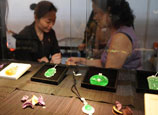
 |
| Distant view of the Songyue Pagoda |
The Shaolin Temple Pagoda has preserved 241 ancient pagodas from between 689 AD and 1803 AD and two modern pagodas. It houses the largest number of pagodas, and was known as the "Chinese Pagoda Art Museum."
The Shaolin Temple Ancestor's Monastery was established in the Song Dynasty between 960 AD and 1279 AD, and is a rare brick and wooden building from the Song Dynasty, and also the original testimony to the "Treatise on Architectural Methods," China's first construction book written by Li Jie in the Song Dynasty. It is also a well-known religious sanctuary to commemorate Bodhidharma, the ancestor of the Chan sect.
The Huishan Temple was established in the Northern Wei Dynasty when the Emperor Xiaowen was on the throne between 471 AD and 499 AD. It preserves nine buildings from Yuan, Ming and Qing dynasties, and was the place where the Master Yixing, an astronomer of the Tang Dynasty, had cultivated himself. The existing buildings from the Yuan Dynasty are from between 1279 AD and 1368 AD, and are the most typical and valuable masterpieces of their time.
The Songyang Academy was established in the Eighth Taihe Year of the Northern Wei Dynasty in 484 AD, and became the head of four academies in the Song Dynasty between 960 AD and 1279 AD. It is one of the oldest academies and also the cradle and communications center of Neo-Confucianism. With its unique layout and remaining items, it has irreplaceable significance in studying ancient Chinese academy buildings, the education system and Confucian culture.
The three towers of the Han Dynasty (Taishi Towers, Shaoshi Towers and Qimu Towers) were established between 118 AD and 123 AD and are the only existing towers in China’s early history, becoming the model of the national sacrificial buildings in ancient China. Pictures of the circus, playing football, magic and cock fighting are carved on the three towers, and they reflect the artistic style of the Han Dynasty and are precious information for studying the architectural history, art history, and social history of the Eastern Han Dynasty.
The Zhongyue Temple was already in existence during the reign of Emperor Wu in the Han Dynasty between 156 BC and 87 BC. The existing architectural patterns can be traced back to the Jin Dynasty, with most buildings being modified in the Ming and Qing dynasties. They are the representatives of the official-style of architecture and also the most complete ancient Taoist buildings with the largest scale and highest standards. The ancient pines of the Qin Dynasty, stone tablets of the Northern Wei Dynasty, and iron man statues of the Song Dynasty in the temple all truly reflect the long history and rich connotations of Taoist culture.


















 Rainstorms flood more than 10,000 cars in underground garages in Wuhan
Rainstorms flood more than 10,000 cars in underground garages in Wuhan


![]()
